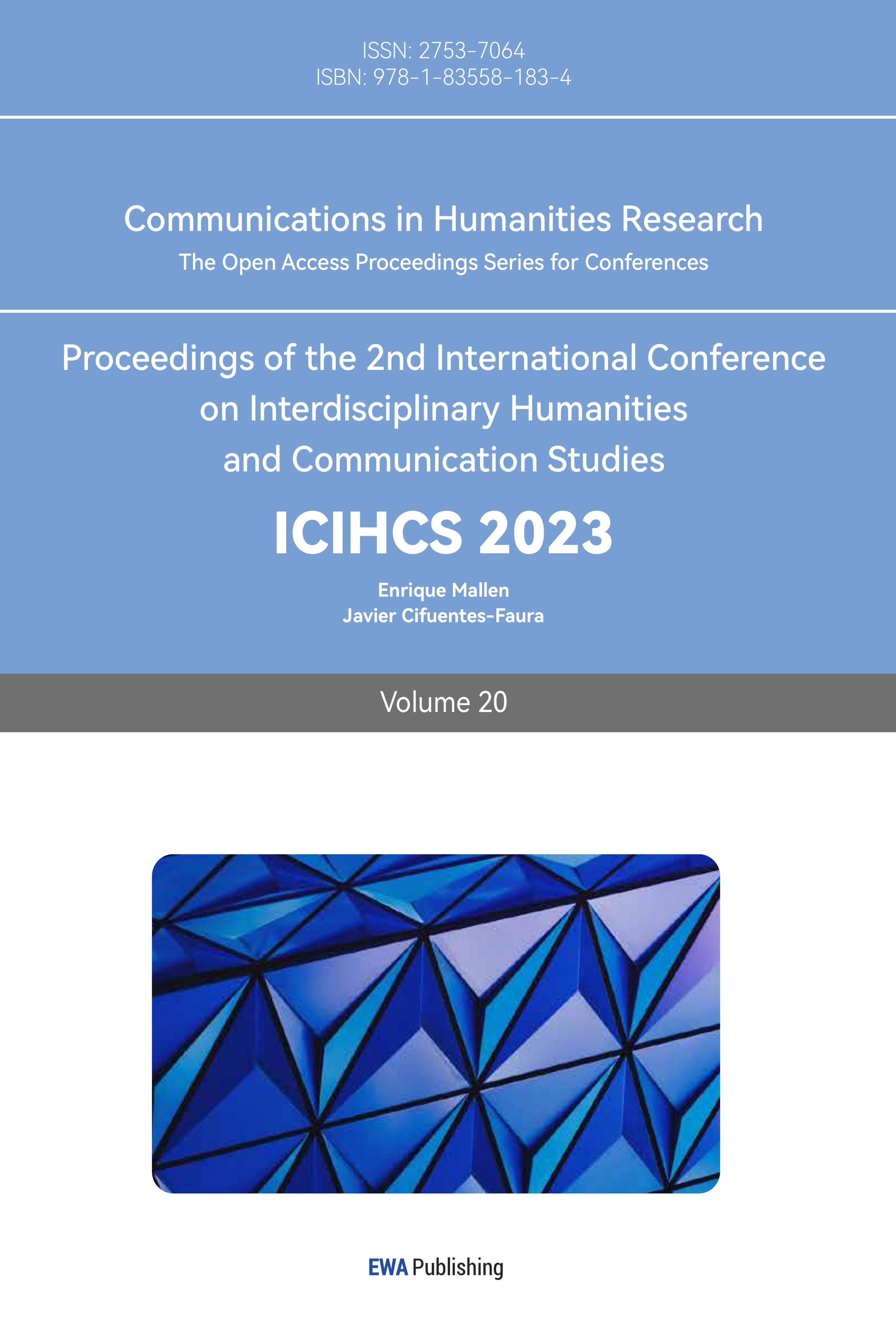1. Introduction
According to studies, there are approximately 3.09 billion active video game players. With the exception of uninhabited Antarctica, online gamers can be found across all continents [1]. The gamers come from different cultural backgrounds, which may cause different heart-flow experiences when playing story-telling games, especially when the story is closely related to a certain cultural group. There is research about strategy game experience relating to gender and cultural background [2]. Another piece of research focuses more on MMOG games in the cultural background relating to women’s rights [3]. However, quantitative research does not make a clear connection between them, and there is not much research about the correlation between horror games, player culture background, and their heart flow experience. Story-telling games are a universally popular game genre. Gamers can play different roles and experience different lives in them. However, this required players to have a strong sense of relatedness that could help them immerse themselves in and empathize with the game characters. In this case, if the story has a strong connection with a certain culture, how much will it affect the player’s heart flow experience? Whether games that are highly associated with a particular culture are a limitation on the game itself are games highly associated with a particular culture appealing to players from that culture while shutting others out? This research mainly focuses on the game “Devotion”, and the author conducted questionnaires and distributed them to students from different cultural backgrounds. By demonstrating the horror pictures from horror games and asking them to rate the scary degrees, there are different results and conclusions. Finding out the relationship between culture and the heart flow experience can help game designers better balance the proportion of cultural factors. This allows them to better identify their target players.
2. Chinese Style Horror Elements Presented in Devotion
2.1. Basic Information about Devotion
Devotion is a first-person view 3D game released in 2019 by Red Candle Games, telling a story about a girl who dies from her father’s superstitions. It is set in Taiwan in the 1980s. The player explores the whole story from the playwriter’s father Du Fengyu’s perspective. To find out the truth, the player needs to explore four different interconnected, similar apartment scenes from 1980 to 1987 [4].
2.2. Horror Elements Category
A successful horror game consists of enormous horror elements. The player’s flow experience is a synthesis of the fear that horror elements produce in the player. Yet Chinese horror has a strong connection with Chinese traditional culture, and its aesthetic qualities are very different from those found in western horror……While Western horror films develop horror elements primarily through the plot, in Chinese horror films, horror is invoked mostly through the use of darkness, unconventional sounds, and the actors’ expressions of terror [5].
Chinese horror films also reflect Eastern aesthetics and elements, expressing the subtle beauty of China, and they cannot be separated from Chinese history and culture. In fact, these elements are not simply a set but can be categorized by their features. It is the unique horror style that makes Chinese-style horror an extraordinary game genre. In Ntokos’s research about horror elements, he divided the elements of horror in horror games into ten categories based on the amount of stimulation they gave the player. In this paper, the horror elements in Devotion will be further analyzed using his table and theory [6].
2.2.1. Explicit Elements
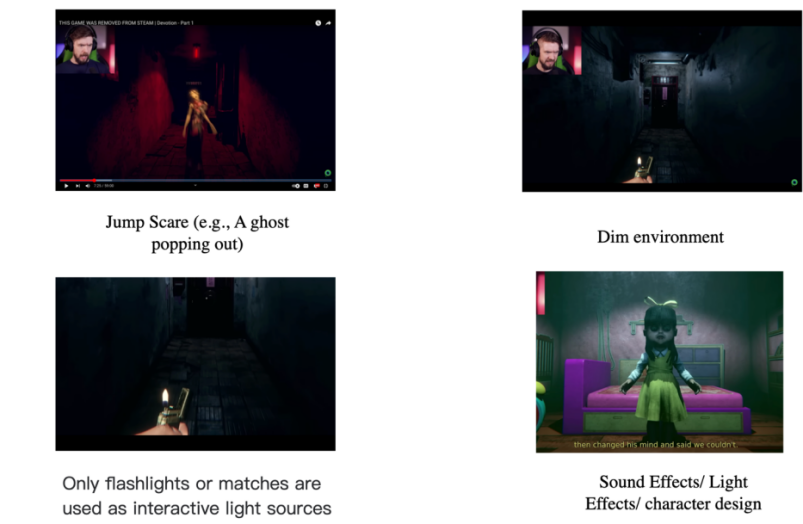
Figure 1: Explicit elements in Devotion.
The first category is the explicit element, which has an intense, immediate, and advanced effect on the player. Figure 1 shows the jump scare (a ghost popping up in the center of the screen), being chased by the ghost, exploring everything in a dim environment, using flashlights or matches as the only light sources, having terrifying sound effects, light effects, or having terrifying character design.
The explicit elements can be called “fair elements” as well, as they provide horror feelings among the player regardless of their cultural background. These elements give the player a level of stimulation ranging from 1 (not scary at all) to 10 (the player chooses to quit the game). Generally, it usually causes strong stimulation, the duration is short, and it does not have a long-term psychological impact on the player.
2.2.2. Implicit Elements
Compared to explicit elements, implicit elements have a closer connection with Chinese culture. It usually does not cause sudden, powerful stimulation, but creates psychological suggestions to the player all the time through sound effects, pictures, etc. Different from other horror games, Chinese horror games are especially good at adding Chinese elements in color, light and shadow, sound, picture, furnishings, etc., to make people feel immersive and mobilize the horror psychology of players.
The plot is the soul of a story-telling game. The storyline of Chinese horror games often incorporates Chinese elements that are relatable to players’ experiences, providing a strong sense of immersion and evoking resonance among players.
Table 1: Comparison between story plot and Chinese reality.
In Devotion | In Reality (China) |
Family argument because Du’s play are not selling, and he cannot accept it. | Family conflict caused by male chauvinism of father/ economic problem; |
Du Meixin’s has mental problems because her parents always fight. | Kid’s mental problem caused by parents who always quarrel; |
Du caused Meixin’s death because he believes in feudal superstition. | Almost every Chinese family believes in superstition more or less. |
Table 1 shows the enormous similarity between the story of devotion and reality in China. Due to the cultural differences between the East and the West, the family background and growth experience of most Chinese people are very different from those of Westerners, such as the traditional family atmosphere, tense and oppressive Chinese education and so on. In conclusion, there is always a story that might happen to all the players.
The preference for narrative sources in Chinese horror games extends beyond daily life to historical stories and era backgrounds. For instance, “Detention,” developed by the same studio as “Devotion,” narrates a tale set during Taiwan’s White Terror period [7][8]. Historical connections provide players, especially those in Taiwan or with experience of the White Terror, with an enhanced immersive experience, facilitating their state of flow during gameplay.
One of the main scenes in the game portrays a conventional Chinese living room, evoking a late 20th-century ambiance. The bedroom scene reflects typical Chinese decor, including a red peony bedspread and wooden bedside table. Another typical example depicts a standard Chinese dinner, using a newspaper as a tablecloth. These relatable scenes form the essence of the Chinese-style horror game [4].
Chinese players feel a sense of familiarity in these scenes, making them feel connected. Thus, it evokes empathy and resonance among the players.
3. Heart Flow in Experiencing Horror Game
There are eight major components of flow. Take a few examples related to this study: the players need clear goals, concentration on task and hand, and a loss of self-consciousness [9]. Since the implicit elements are so related to Chinese culture, players who are not familiar with Chinese culture may have difficulties following the goals and finding it hard to empathize with the characters, which may lead to difficulty getting into a heart-flow experience. If the player is not getting a flow experience while playing, the game is less likely to be enjoyable for the player. Here is a question: would people who know nothing about Chinese culture experience the same degree of heart flow as the Chinese player?
4. Topic and Experiment
4.1. Topic
When digital games are designed for the global market, it is necessary to meet the cultural needs of players in different countries and regions [……] understanding that an action in a particular context can lead to either positive or negative reaction in another context [10].
Determining whether players achieve a state of flow during gameplay can serve as one criterion for assessing the success of a game. There are four reasons that make players so immersed in the characters: A basis of similarity, using first-person visual perspective, reducing the player’s self-consciousness, and the strategy of delayed revelation [11]. Devotion has done a perfect job on these, especially on the basis of similarity among the Chinese players.
4.2. Experiment and Result
4.2.1. Questionnaires
To find out the answer, researchers conducted a questionnaire and sent it to international students and Chinese students living in Shanghai, China (the author is currently receiving undergraduate education at New York University Shanghai). Then the author received 60 answers from Chinese students and 13 answers from international students. Among them, 67 are valid (91.78%).

(a)
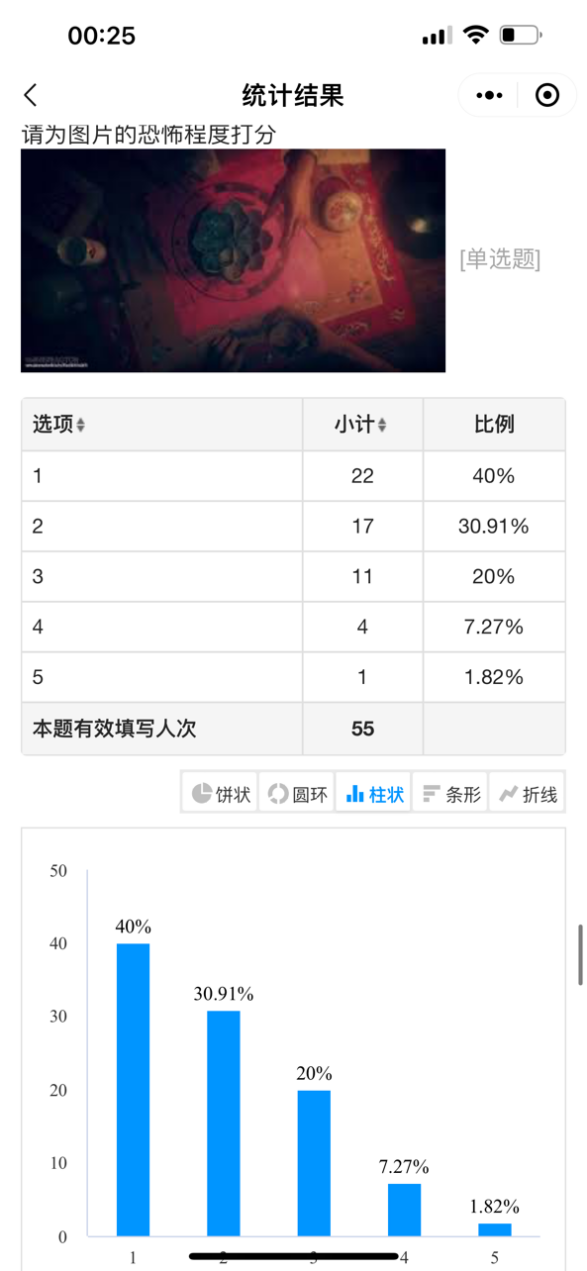
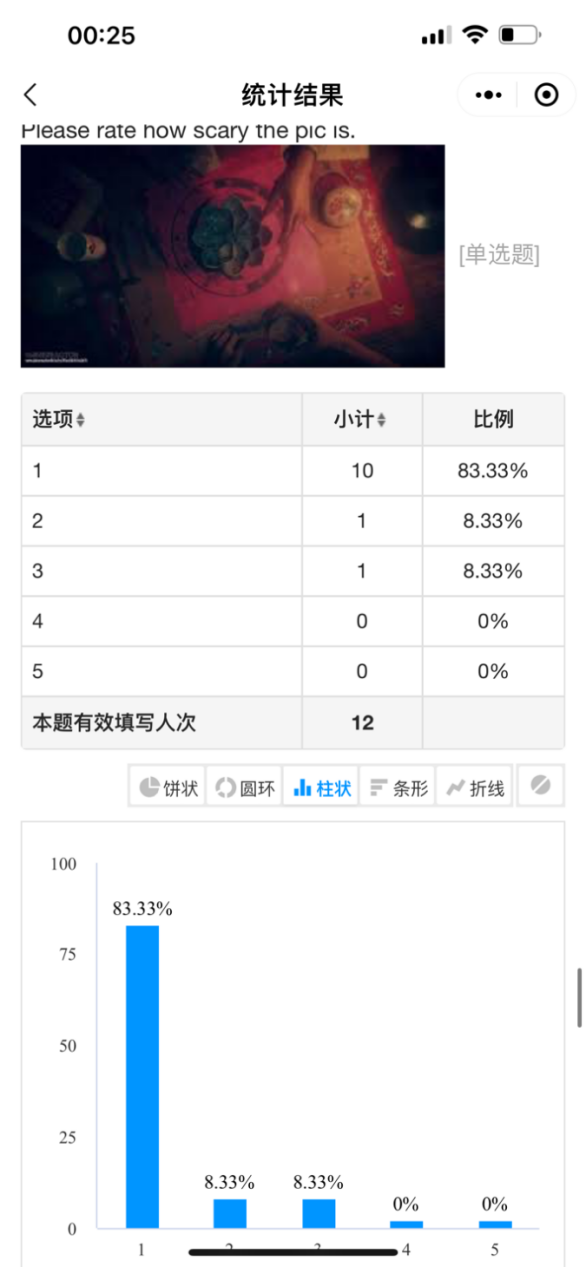
(b) (c)
Figure 2: Questionnaire result 1 [4].

(a)
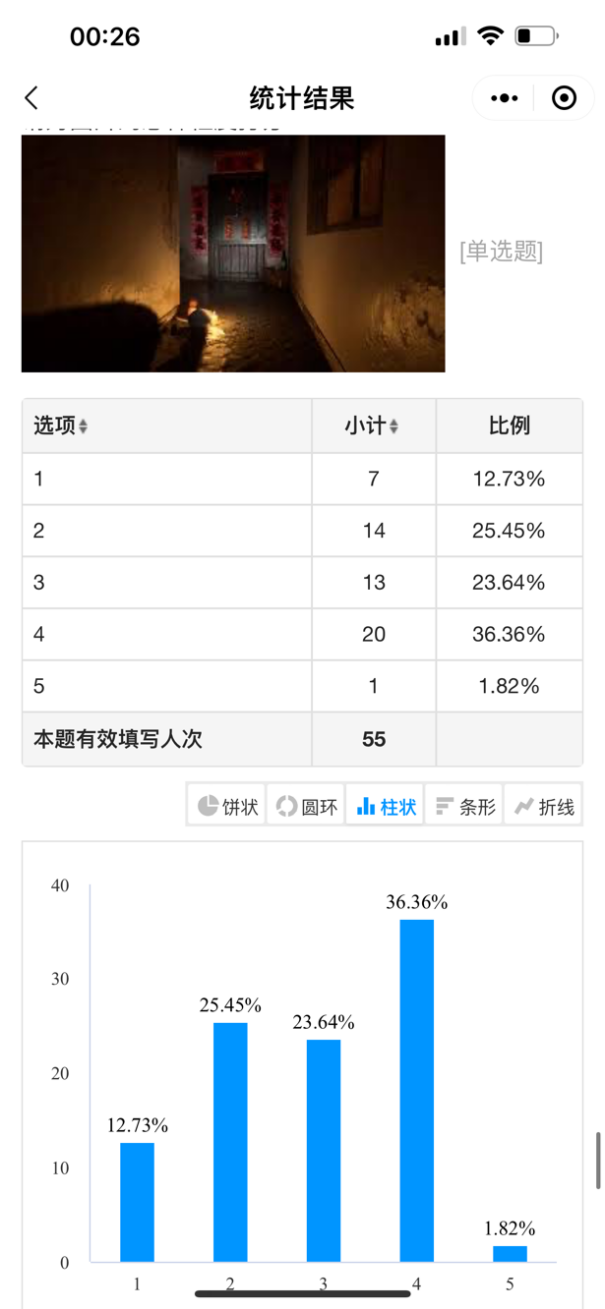
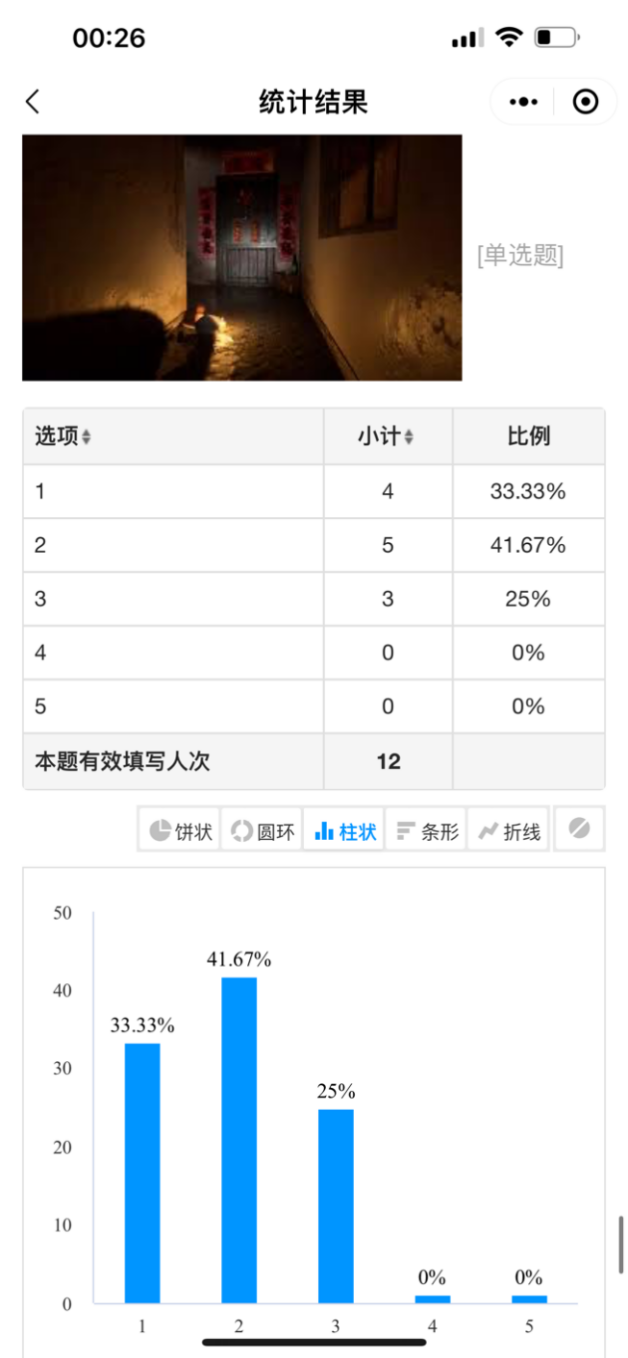
(b) (c)
Figure 3: Questionnaire result 2 [4].
The first results are from Chinese students and the second are from international students. As shown in figures 2 and 3, researchers put some screen shots of the Chinese horror game in the questionnaire and divided the students into Chinese and international groups. Then researchers asked them to rate how scary they thought the pictures were from 1 to 5 (the most terrifying). If a rating of 3-5 means they think the picture is scary, the result shows that for most pictures, Chinese students would find the pictures more terrifying.
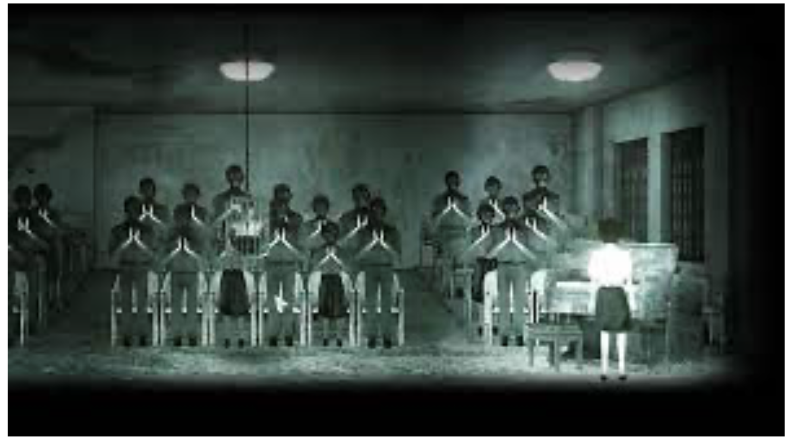
(a)


(b) (c)
Figure 4: Questionnaire result 3 [7].
To ascertain that the experimental outcomes were not influenced by the general higher adaptability of international students to horror games, the author incorporated a game screenshot from “Detention” (figure 4), which is of low relevance to Chinese culture. Thus, if the outcome between Chinese and international gamers have little difference, it shows the research difference above is not caused by the individual courage gap of the players themselves. The results indicated minimal disparity in ratings between Chinese and international students, which effectively substantiated the experimental hypothesis.
Table 2: Research statistic.
Picture number | 1 | 2 | 3 | 4 | 5 | 6 |
Chinese students (%) | 52.73 | 29.09 | 49.09 | 61.82 | 14.54 | 61.81 |
International students (%) | 33.33 | 8.33 | 41.66 | 25.00 | 25.00 | 41.67 |
Based on the experimental results and data, it is evident that horror screenshots associated with Chinese culture received higher ratings from Chinese students compared to international students. Conversely, screenshots with lower relevance to Chinese culture evoked a similar level of fear in both groups.
4.2.2. Realtime Video Analysis
Considering these testing outcomes, the author proceeded to analyze YouTube gameplay videos of Devotion, particularly those crafted by non-Chinese content creators [12]. The results were in alignment with our anticipations. These players exhibited heightened reactions to explicit elements, as indicated in the left image. Nonetheless, when confronted with horror components entrenched in Chinese culture, such as the depicted superstitious ritual, pivotal to the overarching narrative, they encountered a comprehension gap for the segment’s significance. For instance, the ominous Chinese font inscribing “Why don’t you open your eyes” in the right image didn’t resonate due to their inability to read Chinese. The reliance on subtitles curtailed immersive engagement with the horror ambiance.
5. Conclusion
The research demonstrates that the heart flow experience of playing horror games has a high degree of relevance to the gamers’ cultural background. Enhanced familiarity with the cultural underpinnings of a game can potentially engender a more immersive experience by mitigating self-awareness among players. However, games that necessitate an extensive grasp of cultural nuances may inadvertently curtail the overall gaming experience. Specific horror elements, including jump scares and obscurity, wield a universally potent scare impact, transcending cultural boundaries. This study can assist game designers in effectively balancing the disparity in the quantity of explicit and implicit elements within games. This aids them in precisely targeting the game’s audience, resulting in the creation of horror games that can satisfy a broader range of players. Although the experiment yielded conclusions, there remain opportunities for refinement. Due to the inherent cultural background limitations of the researchers, the variety and quantity of collected samples are significantly geographically constrained. Additionally, there is a substantial disparity in the number of valid questionnaires collected from international and Chinese students. Expanding the sample size by gathering more questionnaires from diverse countries and regions could likely yield more compelling and convincing results.
References
[1]. Howarth, J. (2023, August 10). How many gamers are there? (New 2023 statistics). Exploding Topics. https://explodingtopics.com/blog/number-of-gamers#gamer-demographics
[2]. Lukosch, H., Kurapati, S., Groen, D., & Verbraeck, A. (2017). Gender and Cultural Differences in Game — Based Learning Experiences. Electronic Journal of e-Learning, 15(4), pp310-319.
[3]. Zaharias, P., & Papargyris, A. (2009). The gamer experience: Investigating relationships between culture and usability in massively multiplayer online games. Computers in Entertainment (CIE), 7(2), 1-24.
[4]. Devotion. For Microsoft Windows, macOS, Red Candle Games, 2019.
[5]. Li, Y. (2021). Contemporary Chinese Horror Films: Genre, Censorship, Market. University of California, Davis.
[6]. Ntokos, K. (2018). Level of fear”: Analysis of fear spectrum into a tool to support horror game design for immersion and fear. An International Journal (CGDEIJ), 1(33-43).
[7]. Detention. 2019. For Windows, OS X, Linux, Red Candle Games.
[8]. Hanjun Xie, Ruizi Lin. What is “White Terror”?. WatchOut. [2022-10-31]. https://watchout.tw/forum/DHemKc4DG1V2OkyzjHBL
[9]. Chen, J. (2007). Flow in games (and everything else). Communications of the ACM, 50(4), 31-34.
[10]. Pyae, A. (2018). Understanding the role of culture and cultural attributes in digital game localization. Entertainment computing, 26, 105-116.
[11]. Kaufman, G. F., & Libby, L. K. (2012). Changing beliefs and behavior through experience-taking. Journal of Personality and Social Psychology, 103(1), 1.
[12]. YouTube, YouTube, 26 Feb. 2019, https://www.youtube.com/watch?v=rl6-lwoaLZs. Accessed 3 July 2023.
Cite this article
Liu,R. (2023). Chinese-style Horror in Gaming: The Most Terrifying and the Least Terrifying Topic. Communications in Humanities Research,20,52-58.
Data availability
The datasets used and/or analyzed during the current study will be available from the authors upon reasonable request.
Disclaimer/Publisher's Note
The statements, opinions and data contained in all publications are solely those of the individual author(s) and contributor(s) and not of EWA Publishing and/or the editor(s). EWA Publishing and/or the editor(s) disclaim responsibility for any injury to people or property resulting from any ideas, methods, instructions or products referred to in the content.
About volume
Volume title: Proceedings of the 2nd International Conference on Interdisciplinary Humanities and Communication Studies
© 2024 by the author(s). Licensee EWA Publishing, Oxford, UK. This article is an open access article distributed under the terms and
conditions of the Creative Commons Attribution (CC BY) license. Authors who
publish this series agree to the following terms:
1. Authors retain copyright and grant the series right of first publication with the work simultaneously licensed under a Creative Commons
Attribution License that allows others to share the work with an acknowledgment of the work's authorship and initial publication in this
series.
2. Authors are able to enter into separate, additional contractual arrangements for the non-exclusive distribution of the series's published
version of the work (e.g., post it to an institutional repository or publish it in a book), with an acknowledgment of its initial
publication in this series.
3. Authors are permitted and encouraged to post their work online (e.g., in institutional repositories or on their website) prior to and
during the submission process, as it can lead to productive exchanges, as well as earlier and greater citation of published work (See
Open access policy for details).
References
[1]. Howarth, J. (2023, August 10). How many gamers are there? (New 2023 statistics). Exploding Topics. https://explodingtopics.com/blog/number-of-gamers#gamer-demographics
[2]. Lukosch, H., Kurapati, S., Groen, D., & Verbraeck, A. (2017). Gender and Cultural Differences in Game — Based Learning Experiences. Electronic Journal of e-Learning, 15(4), pp310-319.
[3]. Zaharias, P., & Papargyris, A. (2009). The gamer experience: Investigating relationships between culture and usability in massively multiplayer online games. Computers in Entertainment (CIE), 7(2), 1-24.
[4]. Devotion. For Microsoft Windows, macOS, Red Candle Games, 2019.
[5]. Li, Y. (2021). Contemporary Chinese Horror Films: Genre, Censorship, Market. University of California, Davis.
[6]. Ntokos, K. (2018). Level of fear”: Analysis of fear spectrum into a tool to support horror game design for immersion and fear. An International Journal (CGDEIJ), 1(33-43).
[7]. Detention. 2019. For Windows, OS X, Linux, Red Candle Games.
[8]. Hanjun Xie, Ruizi Lin. What is “White Terror”?. WatchOut. [2022-10-31]. https://watchout.tw/forum/DHemKc4DG1V2OkyzjHBL
[9]. Chen, J. (2007). Flow in games (and everything else). Communications of the ACM, 50(4), 31-34.
[10]. Pyae, A. (2018). Understanding the role of culture and cultural attributes in digital game localization. Entertainment computing, 26, 105-116.
[11]. Kaufman, G. F., & Libby, L. K. (2012). Changing beliefs and behavior through experience-taking. Journal of Personality and Social Psychology, 103(1), 1.
[12]. YouTube, YouTube, 26 Feb. 2019, https://www.youtube.com/watch?v=rl6-lwoaLZs. Accessed 3 July 2023.





